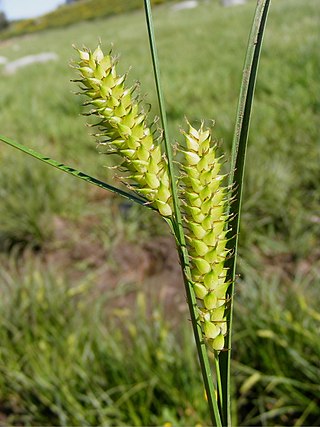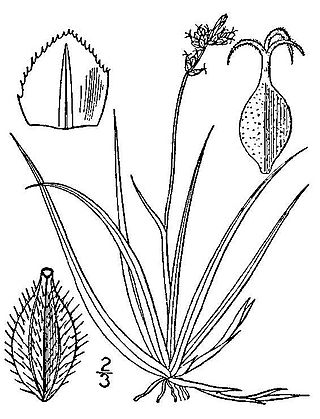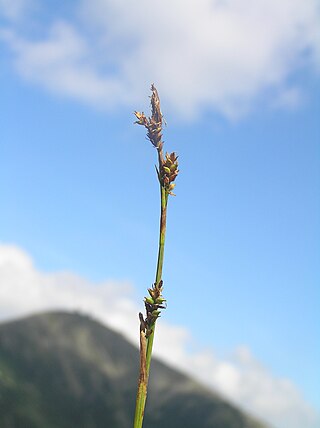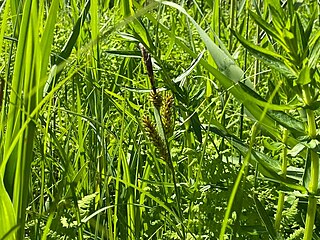
Carex japonica, known as East Asian sedge, is a species of perennial sedge of the genus Carex which can be used like an ornamental plant.

Carex stricta is a species of sedge known by the common names upright sedge and tussock sedge. The plant grows in moist marshes, forests and alongside bodies of water. It grows up to 2 feet (0.61 m) tall and 2 feet (0.61 m) wide. When the leaves die, they build on top of or around the living plant, making a "tussock". Widely distributed in and east of the Great Plains, it is one of the most common wetland sedges in eastern North America.

Carex vesicaria is an essentially Holarctic species of sedge known as bladder sedge, inflated sedge, and blister sedge. It has been used to insulate footwear in Norway and among the Sami people, and for basketry in North America.

Carex pensylvanica is a species of flowering plant in the sedge family commonly called Pennsylvania sedge. Other common names include early sedge, common oak sedge, and yellow sedge.

Carex bigelowii is a species of sedge known by the common names Bigelow's sedge, Gwanmo sedge, and stiff sedge. It has an Arctic–alpine distribution in Eurasia and North America, and grows up to 50 centimetres (20 in) tall in a variety of habitats.

Carex concinna is a species of sedge known by the common names low northern sedge, northern elegant sedge, beauty sedge, and beautiful sedge. It is native to northern North America, where it occurs across Canada and in high elevations in the northern contiguous United States.
Carex garberi is a species of sedge known by the common names elk sedge and Garber's sedge native to North America.

Carex inops is a species of sedge known as long-stolon sedge and western oak sedge. It is native to northern North America, where it occurs throughout the southern half of Canada and the western and central United States.

Carex livida is a species of sedge known by the common names livid sedge and pale sedge.

Carex vaginata is a species of sedge known by the common name sheathed sedge.

Carex lacustris, known as lake sedge, is a tufted grass-like perennial of the sedge family (Cyperaceae), native to southern Canada and the northern United States. C. lacustris us an herbaceous surface-piercing plant that grows in water up to 50 cm (1.6 ft) deep, and grows 50–150 cm (1.6–4.9 ft) tall. It grows well in marshes and swampy woods of the boreal forest, along river and lake shores, in ditches, marshes, swamps, and other wetland habitat. It grows on muck, sedge peat, wet sand or silt, in filtered or full sunlight.

Carex breviculmis, called the Asian shortstem sedge, is a species of flowering plant in the genus Carex, native to Asia from the Indian subcontinent to Southeast Asia, China, Taiwan, Korea, Japan, north as far as Khabarovsk Krai, and Malesia, New Guinea, Australia, Norfolk Island and New Zealand. It has been introduced to the US state of Mississippi. Typically found in forests, it is quite shade tolerant.
Carex deweyanaDewey's sedge, short-scale sedge, is a species of sedge native to Canada and the United States.

Carex rugulosa, also known as the thick-nerve sedge or the slender-culm thick-nerve sedge, is a tussock-forming perennial in the family Cyperaceae. It is native to eastern parts of Asia.

Carex retrorsa, the knotsheath sedge, deflexed bottlebrush sedge, or retrorse sedge, is a widespread species of flowering plant in the family Cyperaceae, native to southern Canada and the northern United States. Preferring wet areas and tolerant of some shade, it is available from speciality nurseries for such uses as ecological restoration projects, erosion control, and rain gardens.

Carex hakonensis, also known as small-needle sedge, is a tussock-forming species of perennial sedge in the family Cyperaceae. It is native to Japan and Korea.
Carex idzuroei, also known as small-Dickin's sedge, is a tussock-forming species of perennial sedge in the family Cyperaceae. It is native to parts of China, Japan and Korea.

Carex onoei, also known as needle sedge, is a tussock-forming species of perennial sedge in the family Cyperaceae. It is native to far south eastern parts of Russia, north eastern parts of China, Korea and northern parts of Japan.















